Frontosa [Cyphotilapia sp. ‘North’ (Burundi)]
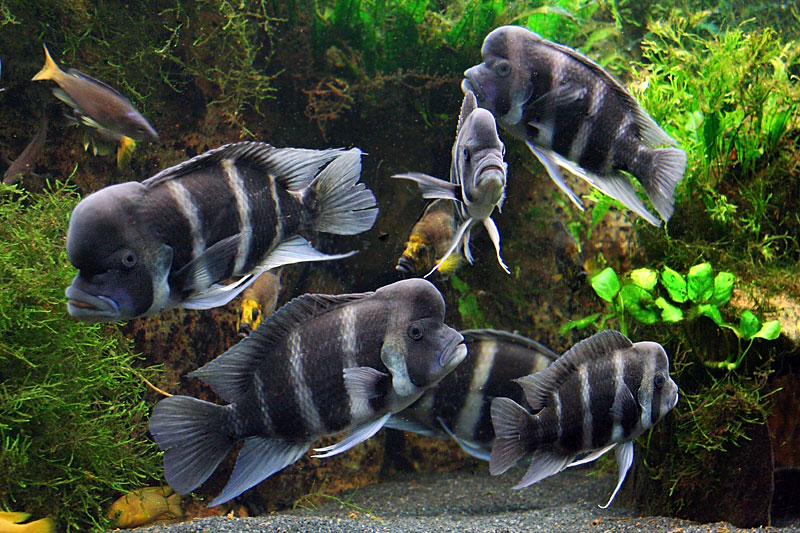 Frontosa in my 240G Lake Tanganyika setup.
Frontosa in my 240G Lake Tanganyika setup.
July 2005
The frontosa are obviously the centerpiece of this tank. I decided on humble burundis over the more fashionable mpimbwe, moba, zaire blue, and what have you, because the burundi were available locally, came at a price where I could afford a large colony, and in my opinion just look drop-dead-gorgeous! Even at the small size I got them - the largest ones were about 2" - they had an amazing amount of blue in them, and some people found it hard to believe that these are really burundis. I got 50 of them from fellow OCA member Dan Woodland. Dan told me that at some years ago he had owned and bred a group of wild caught Burundis that had this stunning coloration. At some stage he sold all of them, but then regretted this decision and bought back some of the F1 fry. These are the parents of my burundis, so they would be F2.
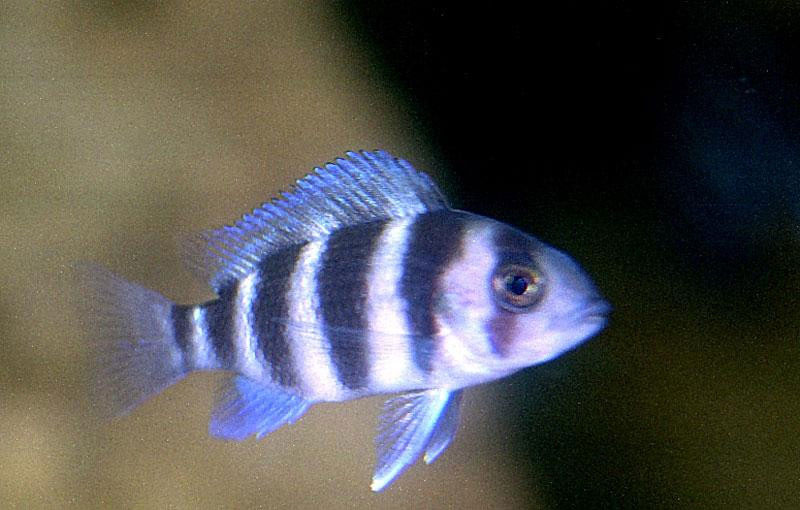
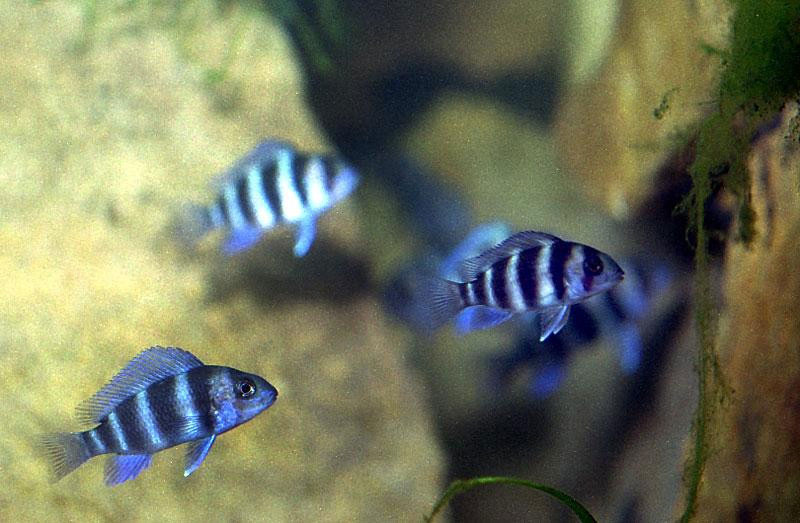
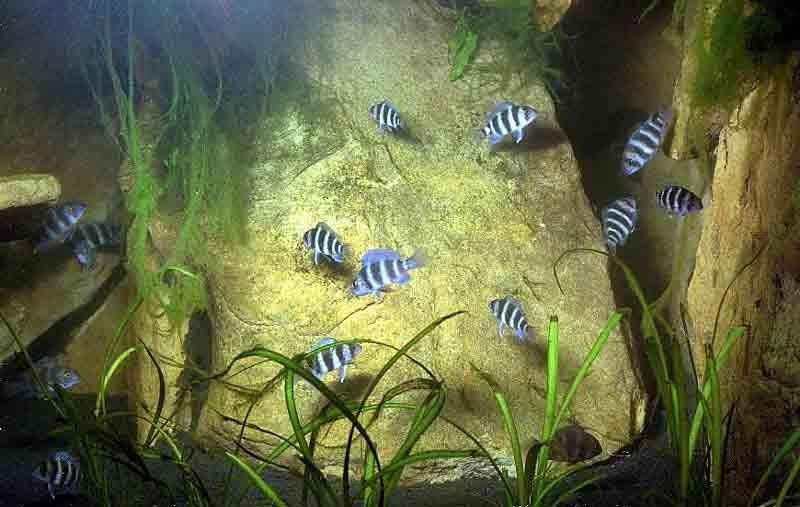 My frontosa in July 2005, just shortly after I got them.
My frontosa in July 2005, just shortly after I got them.
June 2006
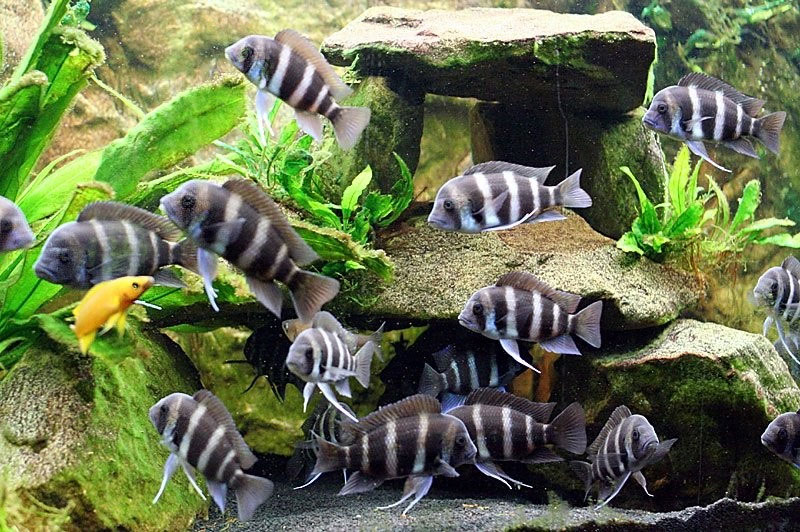
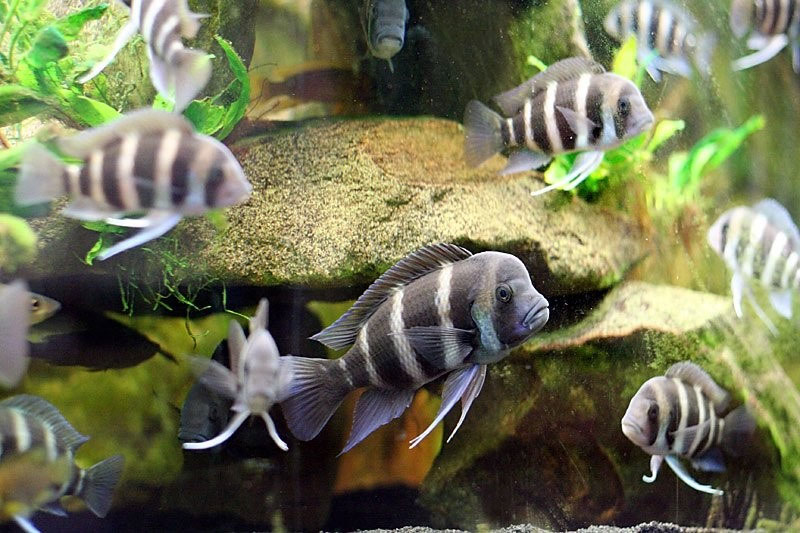 My frontosa in June 2006, almost 1 year after I got them. The one in the second picture in the middle is the alpha male. I thought he looked impressive then!
My frontosa in June 2006, almost 1 year after I got them. The one in the second picture in the middle is the alpha male. I thought he looked impressive then!
November 2006
At the time of writing this, they are about 2 years old and average around 8" in length, with the two dominant males being more around 10" and the smallest females as short as 5". I've lost a few of them, but not many. It's hard to count them even though they are slow moving fish, because there are so many hiding places in this tank. I am guessing I still have about 45. Of the ones that died, I removed only two from the tank. One of them was genetically deformed or must have had some freak accident as a baby. He was always hanging out in one corner and I eventually culled him. The other one jumped on top of the grid on the overflow box and died. At some stage when they were still fairly small, they were all chewing on the leftovers of what had clearly been a fellow burundi. The feast lasted a couple of hours at the most, so it's possible that more died and were eaten at some stage or other, and I missed it. There is one more burundi in there that I would like to cull. It's presumably a female, and has a kind of rotten looking caudal fin. At first glance it appears that the fin has been nibbled at by some other fish, but it had that condition for as long as I can think back and no other fish shows similar symptoms. So it's more likely a disease or genetic deformity and I'd like to get rid of the fish. Yet wanting to catch a fish in a heavily decorated and planted 8' tank and actually getting it are two entirely different things!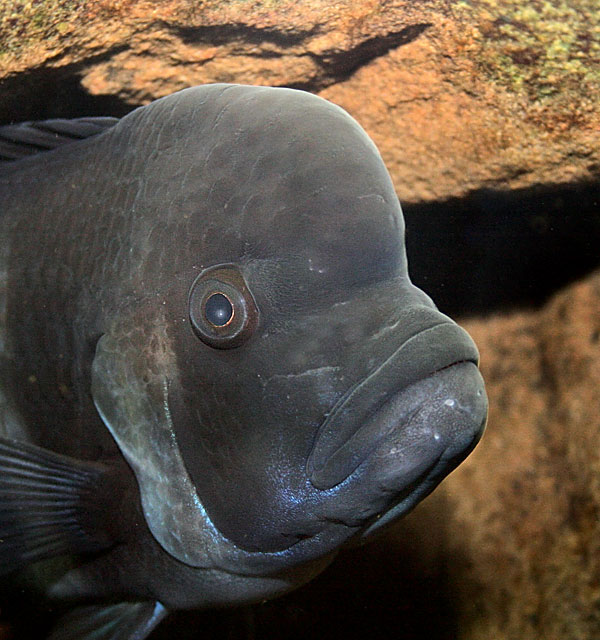 There are always two very large males in the tank that are easily recognizable, because they are by far the biggest fish in the tank and are developing sizable humps. Presumably at this point in time there is enough space for two colonies in the tank, and these are the two alpha males. However, the alpha on the right-hand side, who claims the larger two-story cave, frequently visits the left-hand cave as well. I never see any fighting, so the other wannabe alpha might recognize his supremacy. I don't think they have quite worked out the precise hacking order yet, but then they are all still babies. The left-hand alpha was the one who jumped on top of the overflow box and at some stage and kicked the bucket, but another one quickly grew to his impressive size and fit into his role.
I actually love the Fronts at the size they are right now, and wish they wouldn't become any larger. The main kick I get out of fish-keeping is having a piece of nature right in your living room, and being able to observe the behavior of what are essentially wild fish from your arm chair. That works best with small fish in large tanks, because in this scenario you see most of the natural behavior of the fish. I am not at all into the wet-pet thing of a big fish in a small tank. Obviously 50 adult frontosa will be way too much for a tank of even this size. I'd need a setup like my fellow German Jörg Weisser, but for that I first need to win the lottery. Failing that, at some stage I will have to reduce numbers. I'd definitely like to breed frontosa for a while, and I am guessing that I have at least another year before that even starts. However, eventually I can see this tank growing into a setup for Lamprologine (I am currently growing out some Lepidiolamprologus kendalli), cyps, and shellies, but without the giant frontosa. On other days, however, the thought of a 240G South American setup centered around eartheaters, Xiphophorus montezumae, and some cool plecos enormously appeals to me, and I am just growing out some beautiful Geophagus sp. 'Pindare'. Only time will tell!
There are always two very large males in the tank that are easily recognizable, because they are by far the biggest fish in the tank and are developing sizable humps. Presumably at this point in time there is enough space for two colonies in the tank, and these are the two alpha males. However, the alpha on the right-hand side, who claims the larger two-story cave, frequently visits the left-hand cave as well. I never see any fighting, so the other wannabe alpha might recognize his supremacy. I don't think they have quite worked out the precise hacking order yet, but then they are all still babies. The left-hand alpha was the one who jumped on top of the overflow box and at some stage and kicked the bucket, but another one quickly grew to his impressive size and fit into his role.
I actually love the Fronts at the size they are right now, and wish they wouldn't become any larger. The main kick I get out of fish-keeping is having a piece of nature right in your living room, and being able to observe the behavior of what are essentially wild fish from your arm chair. That works best with small fish in large tanks, because in this scenario you see most of the natural behavior of the fish. I am not at all into the wet-pet thing of a big fish in a small tank. Obviously 50 adult frontosa will be way too much for a tank of even this size. I'd need a setup like my fellow German Jörg Weisser, but for that I first need to win the lottery. Failing that, at some stage I will have to reduce numbers. I'd definitely like to breed frontosa for a while, and I am guessing that I have at least another year before that even starts. However, eventually I can see this tank growing into a setup for Lamprologine (I am currently growing out some Lepidiolamprologus kendalli), cyps, and shellies, but without the giant frontosa. On other days, however, the thought of a 240G South American setup centered around eartheaters, Xiphophorus montezumae, and some cool plecos enormously appeals to me, and I am just growing out some beautiful Geophagus sp. 'Pindare'. Only time will tell!
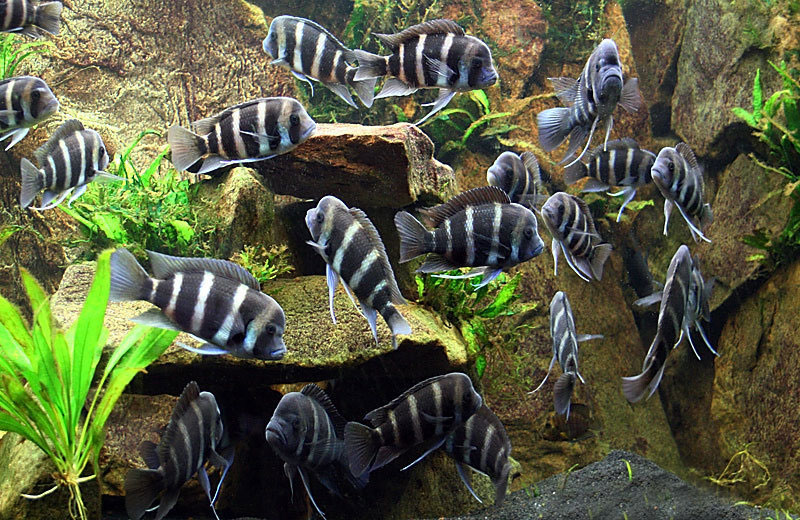
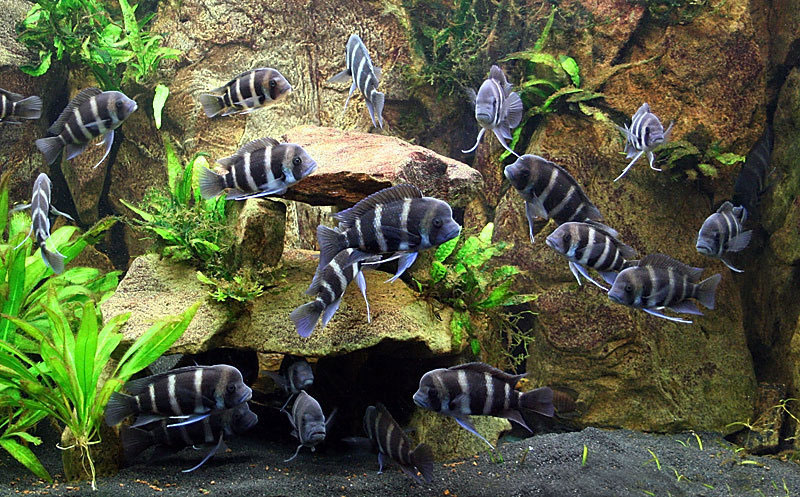 A couple of shots from November 2006.
A couple of shots from November 2006.
March 2007
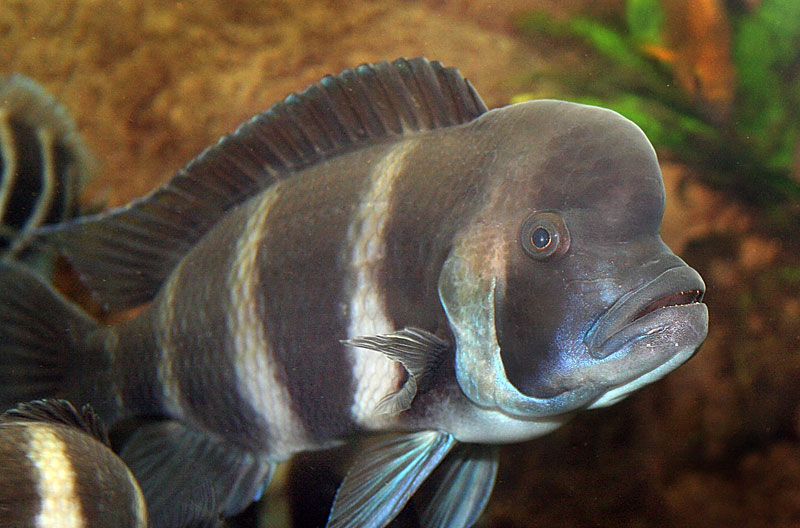
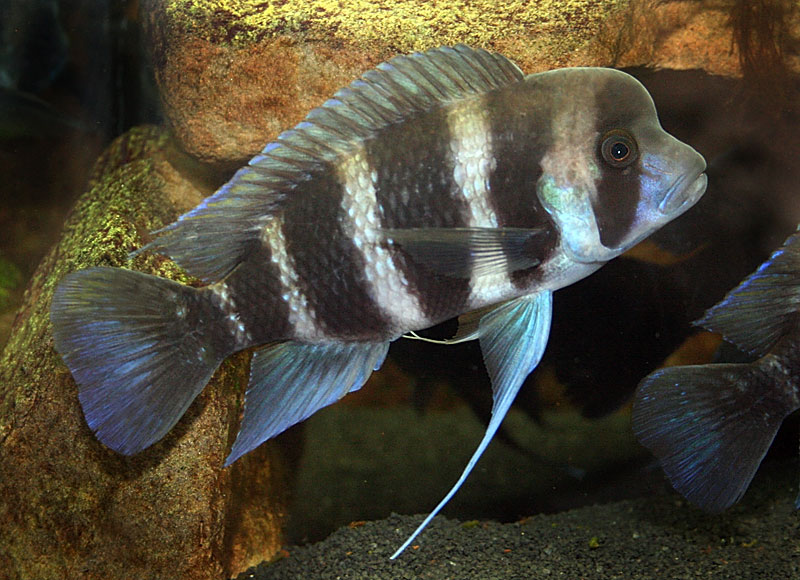
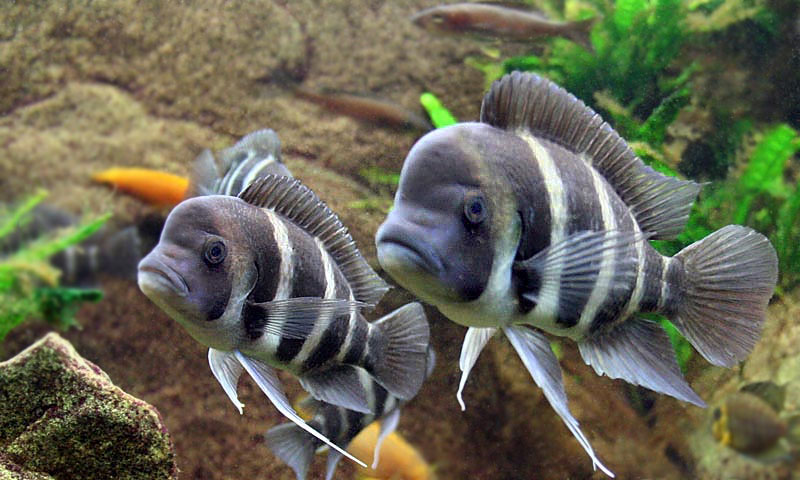 And a few pictures from March 07, when this site was created.
And a few pictures from March 07, when this site was created.
April 2007
 Some from April 2007.
Upon popular request by members of Cichlid-forum, I took a full tank shot and some more photos of the fronts in April 2007. Unless scared and huddling into a corner, it never happens that most of the fronts hang out to together in one area. To the contrary, when all is quiet they seem to space out pretty evenly around the tank. I believe everybody has his/her own corner. And they are now getting to the point were pretty much all space is taken up, including the less popular corners where people more often walk by the tank. The other day one of the fronts decided to 'mow' off the crypts in the front corner. Not that the plants were actually eaten. It simply pulled off every single leaf. I had never seen the fronts show much interest in the plants themselves. They just occasionally dig one out because it happens to be where they want to dig a hole. This time though, I think the front had chosen this particular corner as its territory, and was pruning back the plants to make more space for itself.
Some from April 2007.
Upon popular request by members of Cichlid-forum, I took a full tank shot and some more photos of the fronts in April 2007. Unless scared and huddling into a corner, it never happens that most of the fronts hang out to together in one area. To the contrary, when all is quiet they seem to space out pretty evenly around the tank. I believe everybody has his/her own corner. And they are now getting to the point were pretty much all space is taken up, including the less popular corners where people more often walk by the tank. The other day one of the fronts decided to 'mow' off the crypts in the front corner. Not that the plants were actually eaten. It simply pulled off every single leaf. I had never seen the fronts show much interest in the plants themselves. They just occasionally dig one out because it happens to be where they want to dig a hole. This time though, I think the front had chosen this particular corner as its territory, and was pruning back the plants to make more space for itself.
January 2008
 Pictures from January 2008.
In August 2007 I had entered the three largest males in the Ultra Aqua show of the Greater Akron Aquarium Society. This huge all species show takes place every year in August less than ten minutes down the road from my place. Unfortunately, probably due to a hasty water change with different water, I lost all three fish within a short time at the show. This is highly unusual, and I still don't fully understand how it happened, but I guess that my frontosa are so used to stable water parameters provided by my CAWC, that they could not stomach a sudden 50% water change with different water. I had entered the fish with the hope of creating some publicity to sell some of the stock in my by now overcrowded tank, but of course nobody was enticed to buy my frontosa by seeing the half dead fish at the show! So I had to wait for the OCA Extravaganza 2007 in November, where I sold my 18 largest frontosa and about 20 leleupi. I did not manage to make any sales prior to the auction, mostly because I was busy helping to organize the event, but I got decent prices for them that I was quite pleased with. They certainly earned more than the $200 I had initially paid for the whole colony of 50! After the Extravaganza Dan Woodland, who had sold the frontosa to me 2.5 years ago, and told me that he had lost the last male of his breeding colony, so I returned the remaining largest male to him. At this point in time there are 16 left in the tank, of which I believe three to be males, giving me a male/female ratio if 3/13, which I think is very nice. It also seems a good time to account for the whereabouts of all 50 frontosa I got initially:
16 left as of January 08
Pictures from January 2008.
In August 2007 I had entered the three largest males in the Ultra Aqua show of the Greater Akron Aquarium Society. This huge all species show takes place every year in August less than ten minutes down the road from my place. Unfortunately, probably due to a hasty water change with different water, I lost all three fish within a short time at the show. This is highly unusual, and I still don't fully understand how it happened, but I guess that my frontosa are so used to stable water parameters provided by my CAWC, that they could not stomach a sudden 50% water change with different water. I had entered the fish with the hope of creating some publicity to sell some of the stock in my by now overcrowded tank, but of course nobody was enticed to buy my frontosa by seeing the half dead fish at the show! So I had to wait for the OCA Extravaganza 2007 in November, where I sold my 18 largest frontosa and about 20 leleupi. I did not manage to make any sales prior to the auction, mostly because I was busy helping to organize the event, but I got decent prices for them that I was quite pleased with. They certainly earned more than the $200 I had initially paid for the whole colony of 50! After the Extravaganza Dan Woodland, who had sold the frontosa to me 2.5 years ago, and told me that he had lost the last male of his breeding colony, so I returned the remaining largest male to him. At this point in time there are 16 left in the tank, of which I believe three to be males, giving me a male/female ratio if 3/13, which I think is very nice. It also seems a good time to account for the whereabouts of all 50 frontosa I got initially:
16 left as of January 081 eaten by others
2 culled
3 lost at show
19 sold
9 missing When I did this calculation, I was kind of surprised that I could not account for as many as 9 of them, which is about 20% of my initial stock, and seemed fairly high to me. Yet, I thought it would be interesting for other fish keepers to see these data, because they give you an indication how many juveniles you might want to start with, if you want to end up with a colony of a certain number of adult fish after a period of time. Video from January 2008.
January 2009
Almost four years old now, the tank has matured beautifully. I love all the big plants like Java fern and Anubias, as well as the Java moss and different types of algae overgrowing the rocks and giving the setup a very natural look. My pride and joy are the huge Windelov java ferns. Virtually no plants are left in the substrate - apart from a small thicket of Cryptocoryne sp. in the front left hand side corner. The Frontosa never eat plants, but they do pull them out methodically if they get in the way of creating a territory for one of them. The fish have grown a lot as well - as you can see in the pictures. Pictures from January 2009.
Video from October 2009.
Pictures from January 2009.
Video from October 2009.
March 2011
The first video follows the dominant male on his patrol around the tank. The females are now holding eggs on a fairly regular basis, but the little fronts have virtually no survival chances in the 240G. Only three have managed to survive into adulthood in all the years. Those three were hiding in a bunch of cryptocoryne in the front left corner when I discovered them. At the time, I had plenty of Java moss to spare, and I put a huge clump of it in that corner. The fish stayed for several weeks in the moss, and when they finally emerged, the bigger fish did no longer pursue them. Video from January 2011. Eventually I decided to strip a few females to be able to raise some offspring. The stripping of female mouthbrooders is ethically controversial, especially in Europe. Many fish keepers there assume that the holding of eggs and larvae in the mouth of the female is a behavior acquired by imprinting. The thinking is that if cichlid fry are not held in the mouth by their mother, when those fry grow up they will turn out to be poor mothers, who will not hold their own fry to term. While the existence of imprinting is beyond reasonable doubt, I am not aware of any research showing that mouthbrooding is a behavior acquired in this way, or that any link exists between stripping of females and increased problems with holding amongst their offspring. Another point often made is that stripping causes unduly stress for females, but I am not convinced that removing them from the colony and re-introducing them after they released the fry isn't even more stressful. Stripping is typically over and done with in minutes, and they retain their place in the hacking order of the colony. In my particular case of keeping frontosa in a community setting with a variety of lamprologine and a colony of synodontis catfish, I find that the females are very reluctant to release their fry in the presence of all those predators. Holding beyond the usual time can cause harm and even death to the fry, and great stress for the female. In short, I found stripping to be the lesser evil. The video below shows frontosa larvae in an egg tumbler. The tumbler was a gift from fellow Cichlid-forum moderator Tim Craig aka prov356. Many thanks Tim! Frontosa larvae in an egg tumbler. The next video shows frontosa fry in a 10G tank with lots of Java moss. They are being fed NLS 1mm pellets. Frontosa fry in a 10G with lots of Java moss.
One Response to “Frontosa [Cyphotilapia sp. ‘North’ (Burundi)]”
Leave a Reply
You must be logged in to post a comment.





































February 6th, 2018 at 4:24 am
[…] Cyphotilapia sp. ‘North’ (Burundi) […]